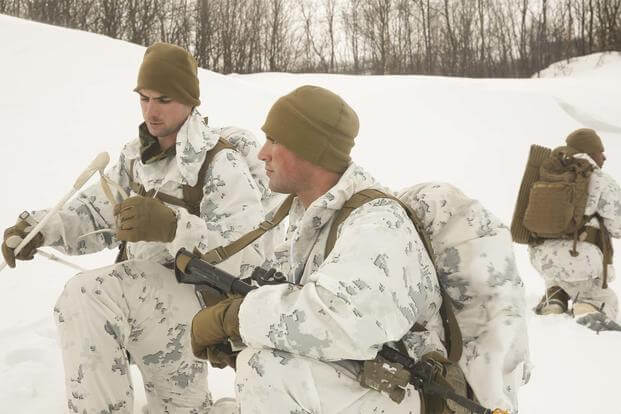Some 285 troops from Camp Lejeune, North Carolina, will find themselves above the Arctic circle in a matter of days as the first six-month rotation of a brand-new Marine force arrives in Norway.
In an interview with Military.com this month, Maj. Gen. Niel Nelson, commander of Marine Corps Forces Europe and Africa, said the new deployment will be known as Marine Rotational Force Europe -- and the first troops arriving as part of the rotation will be a reinforced infantry company from Lejeune's 1st Battalion, 2nd Marines.
The Marine Corps first confirmed to Military.com in October that it was working with the Norwegian government to make arrangements for the force, which will train in Norway and elsewhere in Europe and serve as a measure of assurance and support for allies on the continent.
Norway shares a small border with Russia in the northeast, and many have speculated that the move, which comes as an Army brigade also moves into Western Europe, will serve in part as a deterrent and show of strength in the face of Russian saber-rattling.
Nelson said he views the deployment from a much more practical perspective.
"We've been going to Norway for 25 years. So I don't really know what the hype is about," he said. "We're just doing our job, from a more economical standpoint. I don't put a lot of stock in people pointing back-and-forth."
Having a small full-time presence in Norway will save on the costs of flying troops to the region every year for cold-weather exercises, Nelson said. It will also pave the way for much more intense cold-weather training, and for longer periods of time. This is a goal that Marine leaders have cited as the Corps seeks to diversify training that has been largely focused on desert environments for the last decade-and-a-half.
"By putting Marines in Norway and above the Arctic circle for 30-60 days at a time, that's a whole different environment," Nelson said. "You not only learn to survive, you are surviving. It's a harsh environment; it takes a lot of tough lessons and we reinforce that by the length of time."
Marines arriving this week for the first six-month deployment of Marine Rotational Force Europe will spend the first two weeks at the barracks prepared for them in Vaernes, Norway, where temperatures currently are fairly mild, ranging from 25 to 45 degrees Fahrenheit. Then they will travel above the Arctic circle to Porsangermoen, Norway, where temperatures average in the single digits in January. Soon after, the Marines will participate with British and Norwegian troops in Joint Viking, one of the largest military exercises in the region.
Later in the rotation, Nelson said, the Marines will spend time in the Baltic states, participating in warmer weather exercises.
The Marine Corps and the Norwegian government have agreed on a one-year trial period for the deployment strategy, including two Marine rotations, Nelson said. If the concept is approved on a long-term basis, the deployments will either begin or end with the grueling cold-weather training evolutions, depending on the time of year, he added.
For joint exercises, the leathernecks will take advantage of state-of-the-art Marine Corps vehicles and equipment stored in climate-controlled caves in Trondheim, neighboring their headquarters at Vaernes air station. Part of the long-running Marine Corps Prepositioning Program, the caves house thousands of items, ranging from tanks to generators.
"For every exercise that comes up, we will sign out a level of that equipment, use it for the exercise and return it to the maintainers. And the maintainers will fix it and put it back in there," Nelson said. "We're just tapping into something that's worked well for Marine expeditionary units."
While the Marine Corps has developed and deployed two separate crisis response task forces focused on Europe and the Middle East since 2012, the Norway force is not inherently designed for crisis response. Unlike the two task forces, it lacks built-in aviation elements.
But Nelson said the unit would be ready if called upon to respond to any emerging crisis in Europe.
"I believe that if a crisis was to happen and we needed to use that unit, we would task organize that unit to do crisis, any crisis," he said. There's a lot of things that can go wrong -- natural disasters other maladies that require support -- whether it comes from the NATO nations or the U.S. to contribute. If I'm asked to contribute, I would certainly look at this unit as a capability that can go."
-- Hope Hodge Seck can be reached at hope.seck@military.com. Follow her on Twitter at@HopeSeck.
Related Video:






























